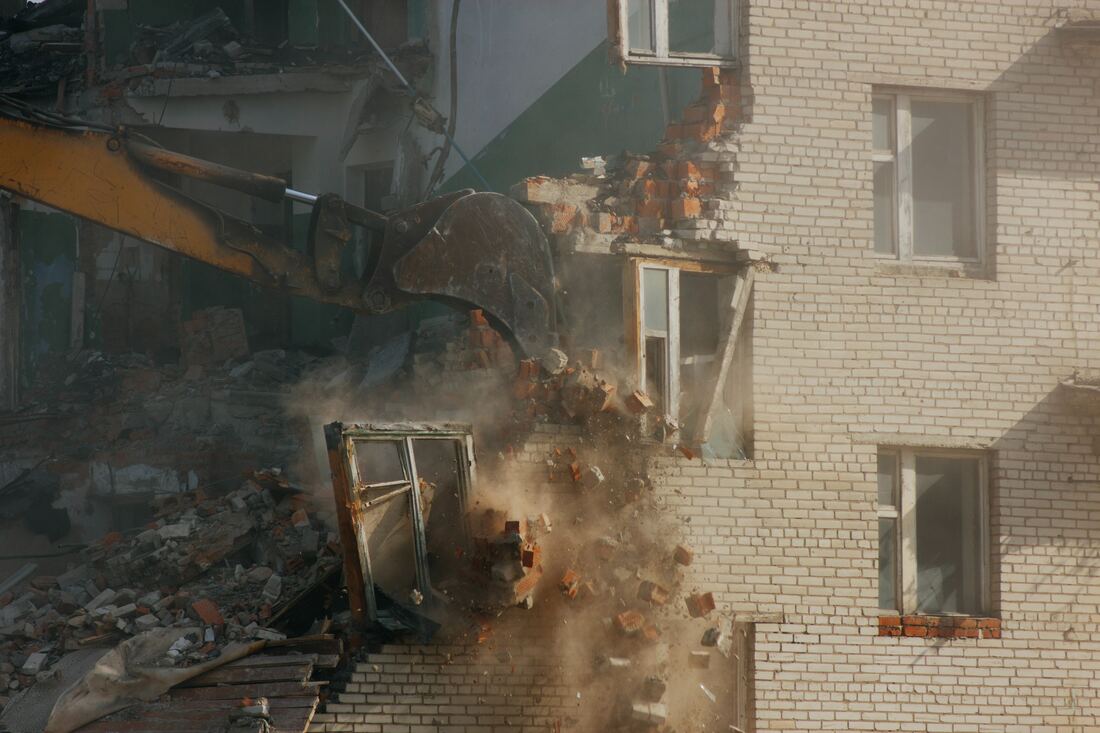|
Since I’ve had a chance to live and spend time in Japan, the United States, and Mexico, not to mention all the time spent in industrial facilities all over the world, I’ve been able to see a number of different approaches to razing buildings. I love the term “razing,” because it can encompass a whole range of different techniques.
The most elegant work I’ve seen is in Tokyo, where space constraints and very strict waste management rules means that buildings are not demolished but are dismantled piece by piece. Here is a great little video that shows some of the challenges and solutions of working in Japan. I’ve inspected many recycling facilities and building sites in Japan, and I will forever be in awe at the degree to which waste materials are separated and recycled, to avoid creating waste that must go into scarce landfill space. We could all learn a lot about recycling from Japan. There is even one technique, Daruma Otoshi, that involves removing a floor at a time, starting at the bottom of the building. This remains one of my favorite ever demolition videos, especially since I’ve spent a lot of time inside the Prince Hotel before it was closed down. And another short video that does a great job of showing Daruma Otoshi in time lapse. With our excess of space and cheap landfills in the United States, we’re not quite so careful. In fact, we’re famous for our method of imploding buildings, which has spread to other areas of the world. There are even highlight reels of annual building implosions, including this one. Of course, we still demolish most buildings with heavy equipment and a lot of time and effort. Two of the most common methods are with a wrecking ball (old school) and with a high reach excavator (newer school). Building demolition in the U.S. can create a huge amount of dust, and cleaning up afterwards is really just picking everything up and trucking it all to a landfill. That means you have to remove any hazardous building materials before any demolition starts. Hazardous building materials can include asbestos, both in insulation and in everything from wall board to floor tiles. Use of friable asbestos was phased out before 1980, but asbestos can still be found in a wide range of building materials at relatively low concentrations. Lead-based paint has a similar story. It is still used on some exterior applications and was used quite a bit on interiors before 1978. Before polychlorinated biphenyls were banned in 1979, they were used extensively as insulation in liquid filled electrical equipment ranging from transformers and capacitors to small fluorescent light fixture ballasts. PCBs were also used as a plasticizer in paint (mostly in places like ships), and caulking. All of these hazardous building materials are strictly regulated as wastes and must be separated from other kinds of demolition waste. Asbestos gets landfilled in specially designed landfills where it can be sufficiently contained. Lead debris gets stabilized by mixing with concrete so that it won’t leach into the groundwater when it is landfilled. And all PCB waste gets incinerated at facilities that are designed to destroy these persistent organic chemicals at a 99.9999% destruction and removal efficiency.
24 Comments
7/26/2019 09:19:41 am
I like how you said that cleaning up after demolition is just picking everything up and throwing it into a landfill. I always thought the process would be more complicated than that. I've been thinking about demolishing part of my house and re-building it, and now I know that the cleanup is relatively simple. Thank you for sharing this information.
Reply
7/31/2019 02:10:31 pm
Thanks for the demolition tips. I would like to demolish my old home and build a new one. I'll work with demolition services to take care of this project.
Reply
12/17/2019 03:26:03 pm
My uncle just bought some extra land behind his home that has another house on top of it, he would like to get the house demolished so that he can have extra space. It could be really nice for him to get a professional to help them demolish the place. It was interesting to learn about how hazardous materials like asbestos, lead paint, and polychlorinated biphenyls should be removed before the demolition.
Reply
Thanks for pointing out that it would be smart to consider looking if there is any lead-based paint on anything you want to demolish. It does seem like a good for me to understand because I would want to get a section of my house demolitions and remodeling. It is a little older so looking out for toxic paint.
Reply
9/3/2020 03:11:22 am
Thank you for writing on the demolition and redevelopment series and should we dismantle or demolish old building. In order to get better information and guidance can be taken from this blog specifically. It plays a vital role in taking us through. It can be really great for people like me who are looking for grabbing more knowledge about. Do visit this https://dklprojects.co.nz/ For vital information that can be used again by anyone
Reply
9/2/2021 02:49:44 pm
Thanks for pointing out that demolition can create a huge amount of dust and cleaning. My husband and I are planning to demolish our cabin near the beach so we can construct a new bungalow house for our parents. With this, we are hoping to find demolition experts on Monday who can tear it down and clean up the site within two weeks.
Reply
10/28/2021 10:51:40 pm
I like how you mentioned that it is important to remove any hazardous building materials before the demolition starts. My uncle mentioned to me last night that his friend is looking for reliable demolition services for their business workplace and asked if I have any idea what is the best option to do. Thanks to this informative article and I'll be sure to tell him that they can consult a well-known demolition service that as they can answer all his inquiries and will provide good-quality service.
Reply
1/14/2022 05:01:46 pm
I never knew that the most elegant work I've seen is in Tokyo, where space limits and stringent waste management regulations mean that buildings are removed piece by piece rather than demolished. I never thought that it would be like this, I'll share this with my aunt. Thank you for the information about demolition.
Reply
3/11/2022 06:11:44 pm
It's interesting when you said that waste management should be implemented for the safety of the environment. My brother is looking for a dependable demolition service for their old property, which will serve as their business location, and has asked me for advice on the best course of action. I appreciate the advice on how to identify the greatest service provider, and I'll be sure to tell him that consulting a well-known demolition service can help them with the plan.
Reply
6/7/2022 02:12:57 am
There is lots of useful information in this article that I would like to share with my friends.
Reply
6/10/2022 01:18:47 am
It was interesting to know that hazardous building materials need to be removed before any demolition begins. My friend should know this since she's getting her old house demolished. I should advise her to hire a contractor that is well-versed in demolition projects.
Reply
Thanks for helping me understand that the hazardous materials should be removed first before the demolition process starts. I will keep that in mind when I hire professionals this year to work on the property that I inherited. I decided to get it destroyed so that I can have my actual dream house built the way I want it to from scratch.
Reply
9/12/2022 04:00:43 am
Thanks for pointing out that it would be smart to consider old buildings should not be immediately demolished because they provide value to society, but eventually they will need to be dismantled. The decision of whether to dismantle or demolish an old building should be based on its condition, the importance of its history, and the costs of demolition or dismantling.
Reply
1/11/2023 10:29:41 am
It's interesting to know that demolition projects create huge amounts of dust, which must be cleaned after. My uncle is interested in demolishing an old structure to start his construction project in a couple of months, so I think he'd read your article to take the necessary steps before the demolition. Thanks for the intake on buildings demolitions and their aftermath.
Reply
6/14/2023 08:29:50 am
I appreciate your insight regarding the consideration of old buildings, emphasizing that they should not be hastily demolished due to their societal value. However, it is essential to recognize that there will come a time when they will need to be dismantled. The decision to either dismantle or demolish an old building should be based on factors such as its condition, historical significance, and the associated costs of demolition or dismantling. Thank you for highlighting this important aspect.
Reply
1/26/2024 01:40:45 am
Demolition services are essential for clearing existing structures to make way for new developments, helping to revitalize urban areas and improve infrastructure.
Reply
4/8/2024 07:41:29 am
It's concerning to hear about the contrast in demolition practices between the United States and Japan, particularly regarding waste management. Your insights highlight the importance of adopting more sustainable approaches globally.
Reply
4/8/2024 07:41:57 am
Thank you for emphasizing the crucial need to address hazardous materials like asbestos and lead during demolition. Your explanation underscores the importance of strict regulation and responsible waste disposal practices to safeguard both public health and the environment.
Reply
4/8/2024 07:42:25 am
We appreciate you shedding light on Japan's meticulous dismantling techniques and their commitment to recycling. It's inspiring to see such dedication to minimizing waste and preserving space.
Reply
5/27/2024 08:53:04 pm
Thanks for sharing this insightful information! The comparison between Japan's detailed recycling methods and the U.S.'s approach to building demolition highlights significant differences in environmental impact and efficiency.
Reply
6/17/2024 09:17:04 pm
Great insights, thanks for sharing! The comparison between demolition practices in Japan and the U.S. is fascinating. The careful, piece-by-piece dismantling in Japan contrasts sharply with the more aggressive methods used in the U.S., emphasizing different approaches to sustainability and waste management.
Reply
6/25/2024 10:31:44 pm
This is very informative, thank you! The contrast between the demolition methods in the U.S. and Japan is striking. The careful separation and disposal of hazardous materials in the U.S. are crucial steps that ensure safety and environmental protection.
Reply
7/2/2024 08:13:46 pm
Great insights, thanks! The comparison between the US and Japan's approaches to building demolition highlights the importance of waste management and recycling.
Reply
7/25/2024 12:36:31 am
Great insights, thank you! The Daruma Otoshi technique is fascinating, and watching the process in time-lapse really highlights the precision and care taken in Japan's demolition methods. It’s amazing how different countries handle building razing.
Reply
Leave a Reply. |
Marty WaltersEnvironmental Scientist Archives
March 2021
Categories
All
|



 RSS Feed
RSS Feed